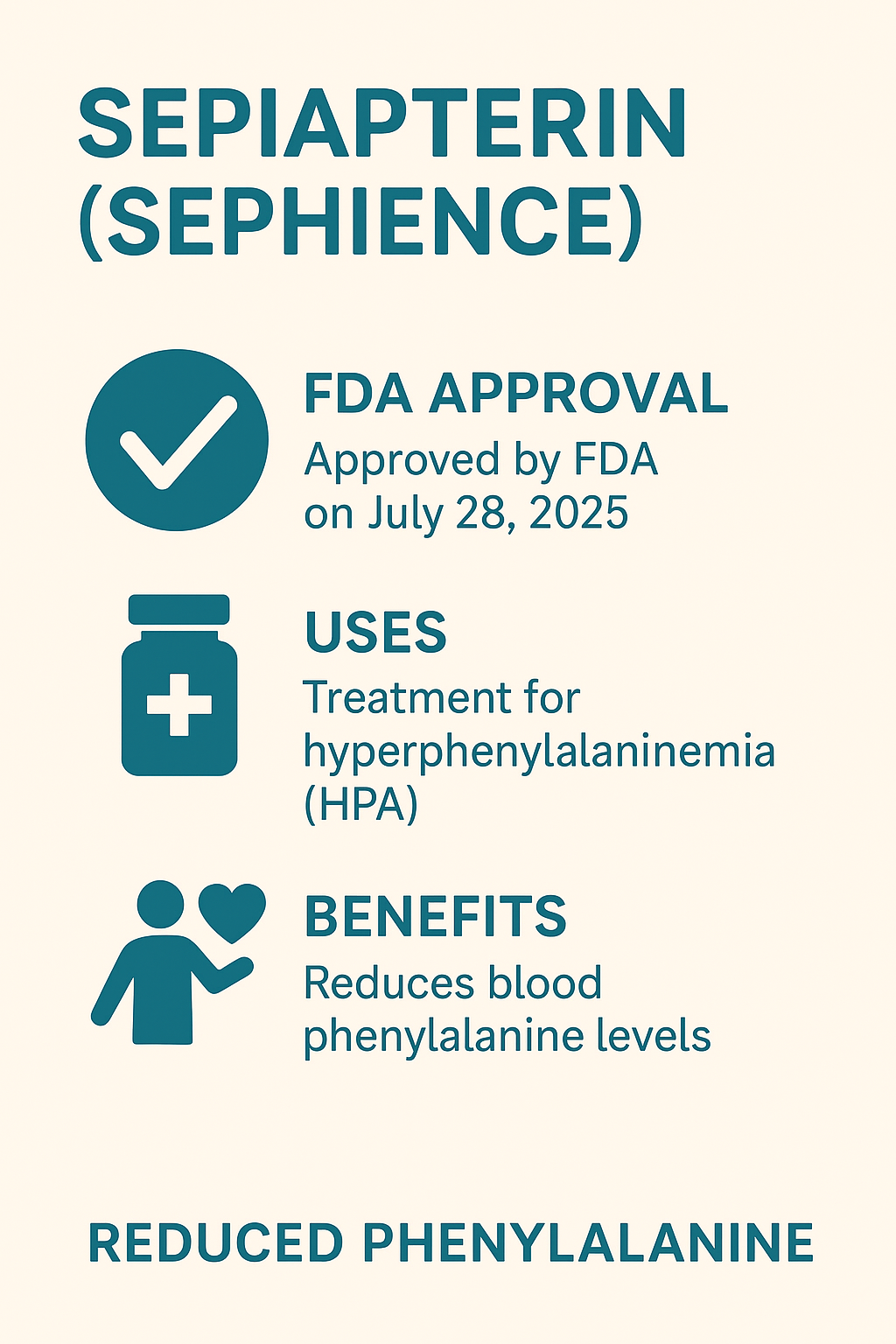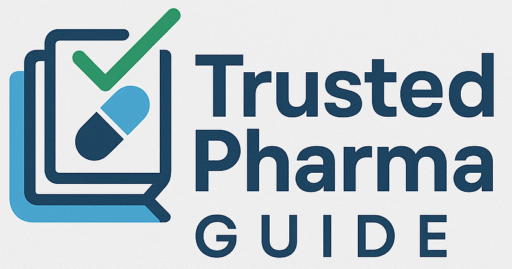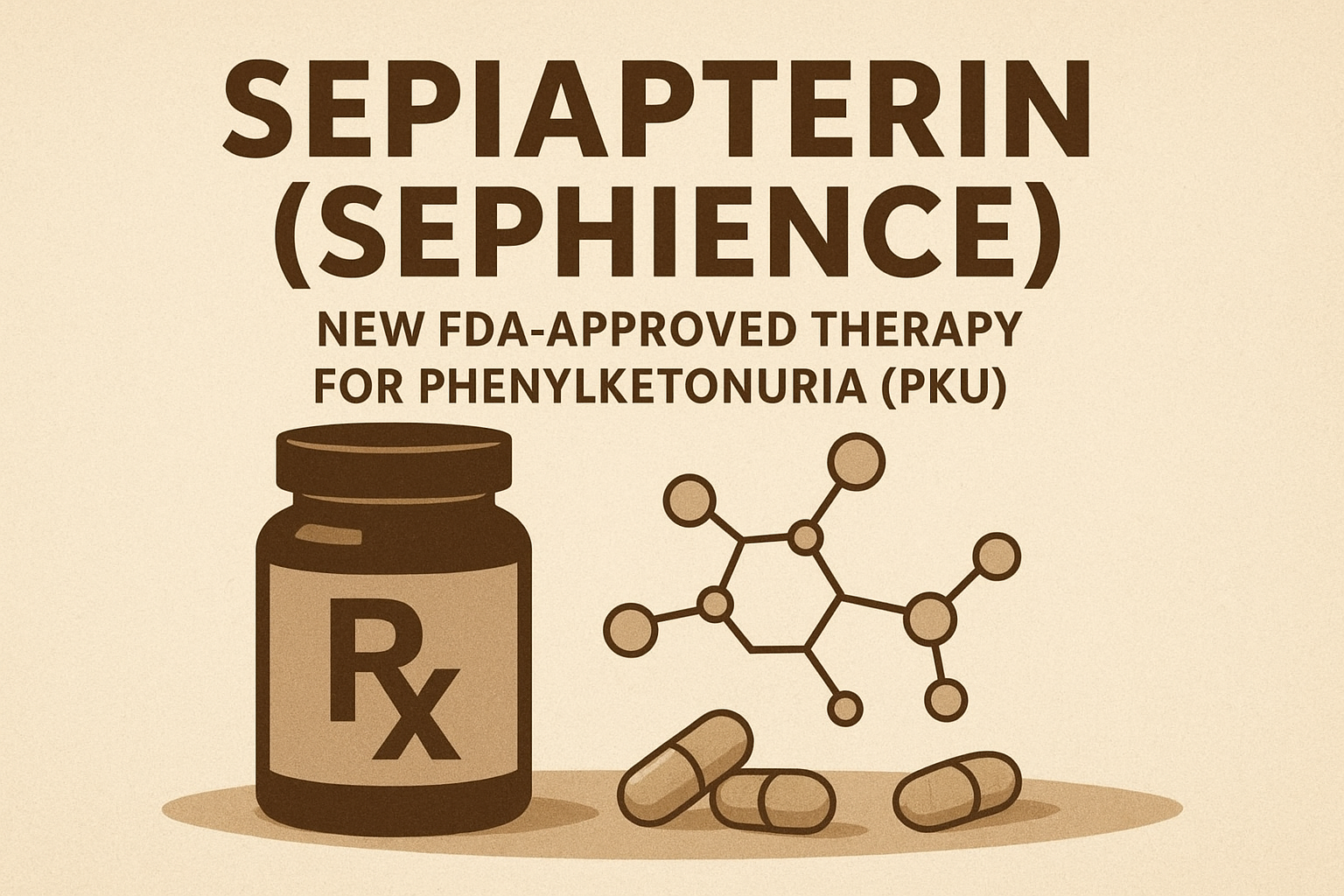Table of Contents
Introduction
On July 28, 2025, the US Food and Drug Administration (FDA) approved a breakthrough therapy called Sephience, which contains the active compound sepiapterin. This approval marked a significant advance in the treatment of hyperphenylalaninemia (HPA), a condition known as phenylketonuria (PKU), in adults and pediatric patients.
PKU is a rare genetic metabolic disorder that impairs the body’s ability to break down the amino acid phenylalanine, leading to dangerous levels in the blood. If left untreated, it can lead to intellectual disability, neurological problems, and other serious complications. Until now, treatment options have been limited, relying primarily on dietary restrictions and some pharmacological approaches.
With the approval of sepiapterin, patients now have a new therapeutic option that can improve quality of life and adherence to treatment. In this blog post, we will explore what sepiapterin is, how it works, its clinical significance, safety profile, side effects, dosage, and long-term benefits for patients with PKU.
What is Sepiapterin?
Sepiapterin is a naturally occurring precursor of tetrahydrobiopterin (BH4), an essential cofactor for several enzymes involved in amino acid metabolism and neurotransmitter synthesis.
- Chemical nature: It is structurally related to pterins, compounds that play critical roles in biochemical pathways.
- Therapeutic use: In patients with PKU, sepiapterin supplementation helps restore normal enzyme function, thereby reducing elevated levels of phenylalanine in the blood.
- Brand name: Sepiapterin is marketed under the trade name Sephience.
The FDA approval of sepiapterin provides clinicians with another disease-modifying option that addresses the underlying metabolic defect rather than just symptom management
Why Was Sephience Needed?
Current Challenges in PKU Treatment
- Strict Diet Requirements – Patients must follow a lifelong low-phenylalanine diet, avoiding high-protein foods like meat, eggs, cheese, and nuts.
- Limited Drug Options – Drugs like sapropterin dihydrochloride (Kuvan) are effective for some, but not all, patients.
- High Burden on Families – Managing PKU in children requires constant monitoring, making treatment adherence difficult.
Sepiapterin provides an alternative therapy with the potential to reduce blood phenylalanine levels more effectively in patients who previously had limited success with other treatments.
How Does Sepiapterin Work?
It functions as a precursor to tetrahydrobiopterin (BH4). BH4 is crucial for the activity of phenylalanine hydroxylase (PAH), the enzyme responsible for converting phenylalanine into tyrosine.
- In PKU patients, PAH activity is reduced or absent, leading to phenylalanine accumulation.
- Sepiapterin supplementation helps bypass enzyme deficiencies by increasing intracellular BH4 availability, thereby enhancing residual PAH activity.
- This results in lower blood phenylalanine levels, reducing the harmful effects of PKU.
In simple terms, sepiapterin helps the body use whatever enzyme activity it has left more efficiently, providing a precision-based therapeutic approach
FDA Approval of Sephience
- Approval Date: July 28, 2025
- Indication: Treatment of hyperphenylalaninemia (HPA) due to phenylketonuria (PKU) in adult and pediatric patients.
- Brand Name: Sephience
- Manufacturer: [Insert manufacturer if known, e.g., A pharmaceutical company developing metabolic disorder drugs].
The FDA approval was based on Phase II and III clinical trials, which demonstrated that patients receiving sepiapterin experienced significant reductions in phenylalanine levels compared to placebo. Importantly, these improvements were observed across both children and adults, highlighting the drug’s broad clinical utility
Benefits of Sephience
- Effective Phenylalanine Reduction
- Lowers toxic accumulation of phenylalanine in PKU patients.
- Alternative to Strict Diets
- May reduce reliance on highly restrictive low-protein diets.
- Works in More Patients
- Some patients who do not respond to other therapies like sapropterin may benefit from sepiapterin.
- Improved Quality of Life
- Less dietary burden, fewer neurological risks, and greater independence for patients.
- Pediatric and Adult Use
- FDA approval covers both children and adults, ensuring access across age groups.

Sepiapterin Dosage and Administration
While the FDA approval provides guidance, exact dosage recommendations depend on patient age, weight, and phenylalanine blood levels. General considerations include:
- Route of administration: Oral tablets or solution.
- Frequency: Once or twice daily, as directed by the physician.
- Monitoring: Regular blood phenylalanine levels must be checked to ensure efficacy.
- Adjustment: Doses may be adjusted based on individual metabolic response
Safety Profile of Sephience
Common Side Effects
Like all medications, Sephience may cause side effects. Reported reactions include:
- Headache
- Gastrointestinal disturbances (nausea, diarrhea, abdominal discomfort)
- Fatigue
- Upper respiratory tract infections
Serious Side Effects (Rare)
- Allergic reactions (rash, swelling, difficulty breathing)
- Liver function abnormalities (requires monitoring)
- Neurological symptoms in rare cases
Drug Interactions
Sephience may interact with other drugs affecting neurotransmitter synthesis. Patients should inform their healthcare provider about all current medications
Clinical Trial Evidence
The FDA approval was supported by randomized, double-blind, placebo-controlled trials. Key findings:
- Significant reductions in phenylalanine levels were observed within weeks.
- Both pediatric and adult patients achieved meaningful biochemical improvements.
- Tolerability was favorable, with side effects being mostly mild to moderate.
- Patients reported better quality of life scores compared to baseline.
These trials confirm that Sephience is both safe and effective for the long-term management of PKU.
Long-Term Outlook for PKU Patients on Sephience
- Reduced Risk of Cognitive Decline – By controlling phenylalanine levels, long-term neurological complications may be minimized.
- Greater Dietary Flexibility – Patients may not need to follow such restrictive protein diets.
- Better Childhood Development – Early intervention with sepiapterin could improve outcomes in children with PKU.
- Potential Combination Therapies – Researchers are exploring if sepiapterin can be combined with gene therapies or enzyme replacement strategies for enhanced results.
Comparison: Sepiapterin vs. Sapropterin
| Feature | Sepiapterin (Sephience) | Sapropterin (Kuvan) |
| FDA Approval Year | 2025 | 2007 |
| Target Patients | Adults & Pediatrics with PKU | Selected PKU patients |
| Mechanism | Precursor of BH4 | Synthetic BH4 analog |
| Response Rate | Broader response across patients | Limited to responsive subset |
| Diet Flexibility | Higher potential | Moderate |
Patient Perspective
For PKU patients, the approval of Sephience is more than just a new drug. It represents hope:
- Parents may have more manageable options for their children.
- Adults with PKU may experience greater independence and freedom.
- The psychological and social burden of dietary restrictions may be significantly reduced.
Conclusion
The FDA approval of Sepiapterin (Sephience) in July 2025 marks a new era in PKU treatment. By addressing the underlying biochemical deficiency, sepiapterin offers a safe, effective, and life-changing therapy for both children and adults with hyperphenylalaninemia.
As research continues, sepiapterin may not only reduce the burden of dietary management but also improve neurological outcomes, social well-being, and overall quality of life for PKU patients worldwide.
For families and healthcare providers, this approval represents a milestone achievement in the fight against rare metabolic disorders.
Frequently Asked Questions (FAQs)
1. What is Sephienceused for?
2. How does Sephience work in PKU patients?
3. Is Sephience safe for children?
4. Does sepiapterin replace the PKU diet completely?
5. When was Sephience approved by the FDA?
6. What are the most common side effects?
Disclaimer:
This content is for educational purposes only and is not a substitute for medical advice. Always consult a qualified healthcare professional before making treatment decisions.

